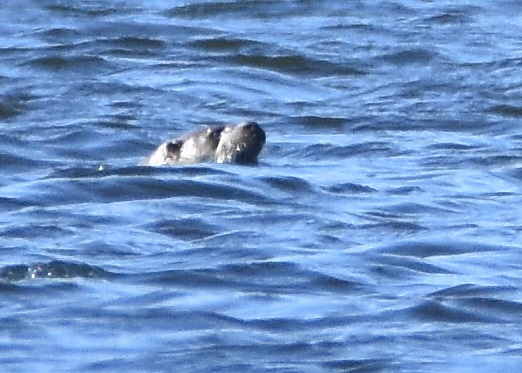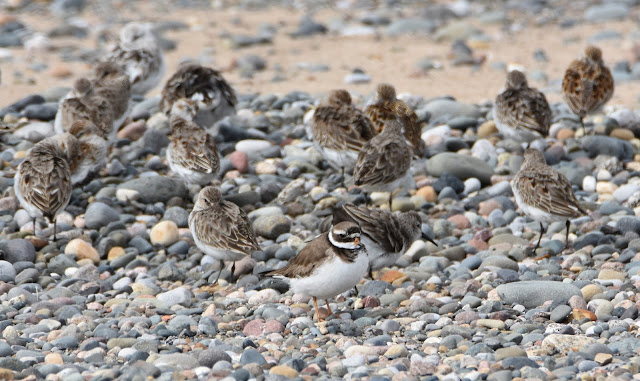The Safari has again had a few short nips over to the sea wall and Patch 2. The other morning we were fortunate enough to see two Linnets out the back at work. We say fortunate when in reality they are now very scarce here after being a regular breeder until the Gorse hedge got too severely hacked in our absence one year. They were seen just after a heavy shower so were probably migrants from who knows where and were feeding voraciously on Dandelion seeds. We raced down the corridor to grab the camera as they were only a few feet from the window but as is always the way they annoyingly had done a flit by the time we got back and were not seen again. Now fueled up and with brighter weather after the shower they were keen to get on their way.
By lunchtime conditions had deteriorated a bit. Looking out to sea it was as hazy as hell, focusing the scope was only possible to about 3/4 of a mile and a very cold north westerly wind was getting stronger by the minute chopping up the sea something rotten.
In the distancee to our left we could see a string of terns making their way towards us. We had to wait a while for them to reach us and in the meantime enjoyed good views of a small number of Manx Shearwaters going past and a flock of 18 Kittiwakes. just beyond the green buoy, so just about focus-on-able in the haze. Not entirely sure how we're going to get these two species on our Year Bird Photo Challenge list as even as close as that they are going to be no more tha ntwo or three pixels even with the 600mm lens.
The terns eventually turned up and the great majority of them were Sandwich Terns but interspersed where at least a dozen Arctic Terns (138, P2 #47) too. We watched them as they passed hugging the troughs to keep their slight bodies out of the head wind as much as possible.Only a couple of thousand miles to go chaps if your off to the high Arctic.
After work we met up with GB and had a mooch round the nature park near his that is also known as a dog toilet. Here we used our new Swazza bins and the first bird ever to be to be seen through them was a fine and dandy male Wheatear, nice one! Over the fenced off grassy areas Skylarks sang with gusto filling the air with their exultations. Walking down to the riverbank where the tide was well up and almost fully covering the marsh we heard then saw a Whimbrel (139, YBC #118) that had been close to the side and heard us coming. There were a couple more and one was almost obliging!
A few Swallows and Sand Martins tazzed upstream as we wandered round chatting but with the plethora of dogs running about there wasn't much bird life to be seen. From one of the pools we heard the whinneying call of a Little Grebe but didn't have a look at the other nor a proper listen at the reedbed although there was a Reed Bunting flitting around there and at least a couple of Reed Warblers singing.
With time up we headed back to the car.
Yesterday we were at the nature reserve at 06.30 and probably and hour too late. It wasn't at all bad but an hour earlier we'd have missed the dog walkers. As soon as we got through the gate at the wetland we heard a new bird for the year, a Sedge Warbler (140, MMLNR #65), it was hunkered down low in the vegetation and wouldn't show properly for a pic. A few yards further on and we heard another new bird, a Grasshopper Warbler (141, MMLNR #66) amazingly we could see it perched up almost in the open a long way off but as soon as we raised the camera for what was ever only going to be a poor record shot it flew.
 |
| It is a Grasshopper Warbler - honest |
Once on the path to the nature reserve another new bird was first heard then sen when a Whitethroat (142, MMLNR #67) started singing its scratchy tuneless ditty from the back of bush and then launched into its song flight. We'll get a pic of that when it lands we though - no it did what its old colloquial name of Nettlecreeper describes and landed in thick low vegetation never to come out again.
On we went mostly to the tune of an almost uncountable multitude if Blackcaps, it wasn't that long ago they were scarce here - not any more! Numerous they are but elusive too and we only saw one briefly so we still haven't got a pic for our Year Bird Challenge. At one point we almost got another pic of a Cetti's Warbler when one exploded int o song inches from our ear from a hawthorn bush on the 'inland' side of the path well away from the lake's edge. It showed rather well in the outer twigs and we'll probably have to wait a long time to get better views of one in our new bins. You've guessed it though, as soon as we swapped bins for camera it was off!
More Whitethroats scratched, Blackcaps fluted, Willow Warblers warbled and Chiffchaffs chiffed (and chaffed) but all from deep cover and we couldn't get the camera on any of them. In the reedbed it was obvious there were many more newly arrived Reed Warblers and some Sedge Warblers too.
At the scrape we met LR coming the other way and as we chatted a Common Sandpiper (MMLNR #68) came in to view. And then we heard a Grasshopper Warbler fire up from the island opposite us.
He went off for his breakfast and we continued round to the embankment where we heard another Grasshopper Warbler close by then another further away - four singing males great stuff! We walked as far as the bridge passing yet more loud Cetti's Warblers and more Reed Warblers and another Whitethroat was over on the island.
Turning back at the bridge and retracing our steps we now saw two Grasshopper Warblers close together at the top end of the embankment while the more distant one in the ditch and the one on the island were still reeling away at each other, a pair perhaps?
Continuing round pastt the scrape we hoped to see the recently spotted Bullfinches in the scrub which is burtsing in to flower, no chance - are they even still here but it really does look good for them. A Lesser Whitethroat (143, MMLNR #69) rattled away from the far side of the scrub.
By now we were being plagued by dog walkers, most allowing their mutts to run around unleashed. We saw a couple more Whitethroats and in good light going back towards the car we stopped to get a pic but each time Monty was disturbed from his very 'good sit and wait' by yet another unleashed dog coming up to him and him moving and yanking our arm...very very frustrating. The adjacent caravan site needs to be a dog-free site and the Public Footpath running through the reserve needs to be moved to outside the fence, there's a perfectly suitable surfaced path going in the same destination only a few yards to the north. We don't mind dogs, well well-behaved ones at least; it's the arrogant twatty owners we don't like!
Almost out of the reserve we watched a small passage of Swallows and Sand Martins and with them was our first Swift (144, MMLNR #70) of the year. We couldn't follow it in the camera as yet another dog came passed making Monty pull at our arm. At the same time about 30 Black Tailed Godwits came in from the east and circled around a couple of times, we think they landed on the scrape but couldn't be totally sure.
Frustrated we wandered a little further and came across another Lesser Whitethroat rattling away unseen deep in the scrub.Not keeping hidden in the scrub was one of the Sedge Warblers (YBC #119) we passed on the way in and it was still showing very well in the Raspberry thicket. We stopped and snapped away.
Beautiful little thing shame it's song can't quite be described as beautiful too!
A little further on at the edge of the wetlands we heard the Grasshopper Warbler (YBC #120) again. Again we could see it and tried to sneak round to get a clearer view. As we walked through the grass we disturbed a second from almost under our feet, Another pair perhaps? The male continued to reel away as we moved round. It was more or less in the same twigs as it was first thing. All of a sudden two weird things happened. The camera refused to find a focus point, battery was dying and for the first time ever outside Monty started barking and jumping up at our back - bonkers what was all that about? Anyway we only managed a couple of shots before the battery totally died and Monty's antics flushed the bird and this was easily the best shot we got.
A good morning out on safari but a frustrating one too.Where to next? Strong easterly winds at this time of year mean Black Terns but we've got family duties so we hope some will stick around locally over the holiday weekend.
In the meantime let us know who's reeling away in your outback

















































